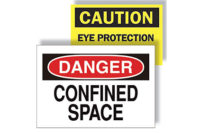Digital signage is growing in popularity as a powerful communications tool for workplaces. Innovations include use of touchscreen technology, video walls, digital fabric graphics, and high-resolution content displays.
Billboards, restaurant menus, and highway signs are all beginning to move from traditional signage to digital signage. Digital signage features colorful and moving displays, and also allows companies to share more content.
Touchscreen technology in digital signage continues to advance. From hands-free 3D displays to light measuring surface areas, companies are developing different touchscreen technologies for digital signage use. But unlike smartphones or tablets, users don’t feel the seamless interconnectivity of touchscreen technology when used in digital signage. One idea is to create recesses on the screen to imitate a keyboard, which would make the user feel more connected to the signage.
Graphics printed on high-quality fabric have existed for years. By installing a screen behind the fabric graphic, signage comes to life and creates more light, motion, and color than traditional fabric graphics alone.
Along with digital fabric graphics, new technology allows digital signage to be created in new shapes, sizes, and configurations—curved digital signage, massive high-definition screens, outdoor waterproof screens. Digital signage can now be configured to fit the needs of any space. This allows companies to create custom and unique digital signage for numerous placements.








